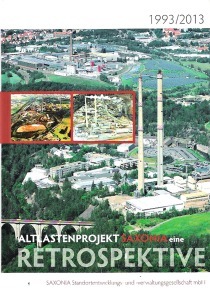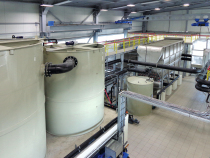Innovative pilot plant delivers promising results
“Even more than 50 years after the closure of the tailings pile, the leachate we are working with here is still heavily contaminated with aluminum, cadmium, zinc, manganese, and other metals,” explains project manager Prof. Sabrina Hedrich, professor of microbiology and biohydrometallurgy at the TU Bergakademie Freiberg. “It is also contaminated with low pH values and high sulfate concentrations. Even though there is no danger to humans, we urgently need to find solutions to minimize the impact on nature.”
 The pilot plant for a novel water treatment process has been in operation at the Hammerberg tailings pile on the eastern outskirts of Freiberg since July 2024
The pilot plant for a novel water treatment process has been in operation at the Hammerberg tailings pile on the eastern outskirts of Freiberg since July 2024
© TU Bergakademie Freiberg
Three stages to clean water
The plant itself looks unspectacular: the water flows from storage tanks through the cascade-like treatment plant, where it is purified step by step. In the first treatment stage, the pH value of the acidic water is raised from approximately 4.9 to neutral pH values between 6.5 and 7.0 with the aid of a limestone filter. During this process, the aluminum dissolved in the water precipitates as aluminum hydroxide and can be collected.
The second treatment stage is a so-called bioreactor, which contains a mixture of limestone, wood chips, straw, and compost – the so-called biomix. It provides ideal living conditions for bacteria that produce hydrogen sulfide from the sulfate in the seepage water. This in turn ensures that the metals contained in the water are precipitated as metal sulfides and retained in the biomix. The third and final stage is a plant basin, which acts as a natural treatment plant, filtering remaining pollutants and suspended solids from the water.
 The pilot plant cleans the contaminated seepage water in several stages using a combination of (micro)biological and chemical processes
The pilot plant cleans the contaminated seepage water in several stages using a combination of (micro)biological and chemical processes
© TU Bergakademie Freiberg / A. Hiekel
Promising results and global applications
The MindMontan project will come to an end at the end of this year. The results achieved by the research team over the past few months are promising. “We were able to show that our process is capable of efficiently removing pollutants from the water,” says Prof. Sabrina Hedrich. “It is also cost-effective and can later be integrated into remediation landscapes as a large-scale plant. This makes it interesting not only for our region, but also for mining landscapes worldwide.”
According to the EU Water Framework Directive, all European waters should have achieved good ecological and chemical status by 2027. The process developed in the MindMontan project can contribute to this. “In Saxony alone, over 1300 km of streams and rivers fail to meet the good status due to mining-related and sometimes very high metal pollution, which is transported downstream from its source. The catchment areas of the Freiberger and Zwickauer Mulde rivers are particularly affected,” explains Christine Stevens, water protection officer at the Saxon State Office for Environment, Agriculture, and Geology. “Cost-effective and sustainable long-term solutions, such as the nature-based, passive water treatment technologies developed in the MindMontan project, are urgently needed. This will minimize the environmental impact of local historical and potential new mining activities.”
The MindMontan project
Duration:
May 1, 2023, to December 31, 2025
Funded by the Federal Ministry of Research, Technology, and Space in the “WIR! – Change through Innovation in the Region” program
Partners:
TU Bergakademie Freiberg, Institute of Biosciences, Microbiology and Biohydrometallurgy Working Group
G.E.O.S. Engineering Company
Friends of the Ore Mountains Mining Region Association
Project supporters:
Saxonia Location Development and Management Company, Saxon
State Office for Environment, Landscape and Geology, Mittelsachsen District, State Directorate of Saxony
Meyer Burger GmbH
More about the project:
Website: https://mindmontan.de
Project video: https://youtu.be/LBV5C3wTcQk
Contact for inquiries: Prof. Sabrina Hedrich,
email:






